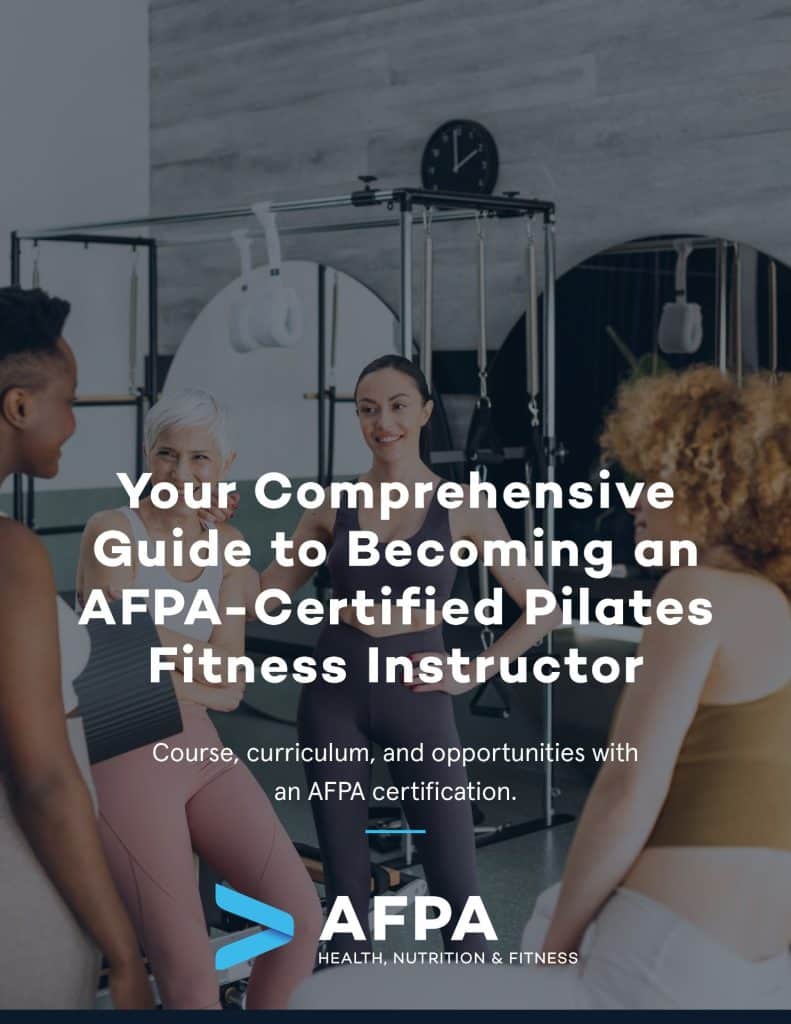According to a 2021 report published by Research Dive, the global Pilates and yoga studios market is expected to garner $269,301.8 million in revenue between 2021 to 2028 – growing from $127,698.8 million in 2020 (a healthy compound annual growth rate of 10%).
Now, if you’re interested in kickstarting a career in this rapidly growing industry as a Certified Pilates Fitness Instructor, read this article.
Here, we cover everything you need to know about becoming a Pilates instructor – including key considerations (e.g., personality and financial), what to look out for in a good certification program, and valuable tips on scoring your first paying client.
What Is Pilates?
First developed for rehabilitation purposes in the 1920s by Joseph Pilates (a German physical trainer), Pilates is a type of exercise that focuses on improving flexibility, strength, and awareness through controlled movements.
The most important aspect of Pilates training centers around trunk stability through core engagement. Pilates movements tend to be functional; examples include toe taps, leg extensions, and abdominal curls.
So, unlike some forms of exercise, Pilates – thanks to its functional movement patterns – can help exercisers achieve strength without increased muscle mass.
Beyond that, other benefits exercisers could gain from practicing Pilates include:
- Increases flexibility: With its heavy focus on stretching, it only makes sense that research shows the regular practice of Pilates to boost overall flexibility – which, in turn, brings about many physical benefits. Examples include a reduced risk of injury, a greater range of motion, and improved balance.
- Improves posture: Poor posture, like rounded shoulders or anterior pelvic tilt, typically results from muscular imbalances and are exacerbated by “bad” daily habits (e.g., hunching over the laptop or mobile phone). So, Pilates’s emphasis on proper full body alignment, a balance of all opposing muscles, and better body awareness could help address postural issues.
- Chronic back pain relief: Pilates’s core-centric moves could help exercisers reap the benefits of a strong core, like lower-back pain relief. Take this 2019 study, for instance. Participants with a range of chronic musculoskeletal conditions—including nonspecific low back pain—reported a reduction in pain levels after completing a twelve-week Pilates program.

Learn How to Become a Pilates Instructor Online in Less Than 6 Months
Types of Pilates
There are two types of Pilates:
- Mat Pilates: A form of Pilates done on a mat, which is just a little thicker than the standard yoga mat (to cushion pressure points). This is the most accessible form of Pilates.
- Reformer Pilates: A form of Pilates done on a machine called a reformer—a sliding platform complete with a stationary foot bar, springs, and pulleys that provide resistance.
Can’t decide between the two? Don’t sweat it.
The underlying concept for both Pilates types is the same: with the key focus hinging around the concept of control rather than rushing through endless reps or achieving muscle exhaustion.
Still, there’s a unique advantage to enrolling in a Pilates Fitness Instructor Certification focused on mat exercises that’s worth noting. Most gyms and fitness centers offer mat classes, which means you’ll likely be in better demand as a Pilates instructor and could, thus, get started helping clients reach their personal fitness goals right away.
That said, let’s not get ahead of ourselves. There are still a few more things you need to do before conducting your first class as a Certified Pilates Fitness Instructor.
#1: Know What It Takes to Become a Pilates Instructor
First things first, do carefully consider whether becoming a Pilates instructor is truly the right calling for you (before you start on a certification program only to find that you don’t even like it that much):
- Passion for fitness: Your love for Pilates—and for leading an active lifestyle—will serve as a crucial motivator for clients, so it’s vital for you to enjoy physical fitness.
- Interpersonal skills: Are you a “people-person”? Do you have a friendly personality and strong communication skills? While you may not necessarily need to be the most extroverted person in the room, the idea of guiding people through their workouts shouldn’t scare you (especially since Pilates tend to be held in a group format).
- Motivational skills: As a Pilates instructor, you’ll take charge of supporting clients in achieving their health and fitness goals. And that typically involves the use of motivational interviewing, a technique designed to support clients in progressing through the stages of behavior change in a way that makes the most sense for them. You should thus be honest with yourself: Would you be interested in doing this?
Of course, don’t be discouraged if you aren’t equipped with the above-mentioned soft skills (e.g., interpersonal skills and motivational interviewing skills). You could pick up many of these soft skills by undergoing a well-reviewed and comprehensive Pilates Fitness Instructor Certification program and, subsequently, on-the-job practice.
The main thing you need to consider here is whether you’d be happy (and find fulfillment) in helping clients lead healthy, active lives through Pilates.
#2: Choose the Right Pilates Certification Program for You
But with so many programs available, finding “The One” that’s right for you can feel like you’re searching for a needle in a haystack.
Well, here are a few things you could do that’ll help you in the shortlisting process.
First, decide which area of Pilates you’d like to specialize in (i.e., mat or reformer). Feel free to immerse yourself in a good mix of both types of Pilates classes; these classes can give you a good idea of which specialization you’d most enjoy teaching.
Next, think through your target client group (e.g., women-only or seniors) as a Pilates instructor.
Then, once you’ve “trimmed down” your list of top choices, screen each certification program carefully to ensure that it covers the following essential Pilates topics:
- History, principles, and evolution of Pilates
- The core stabilizing muscles used for different exercises
- Basic Pilates mat exercises for group and one-on-one settings (Note: Mat Pilates exercises will serve as “foundation” knowledge, no matter your specific specialization.)
- How to use Pilates exercises to address overuse injuries, arthritis, postural disorders, lower back pain, and misaligned issues
- How to identify client readiness for specific Pilates exercises
- Effective and professional communication with clients
Finally, consider the following aspects:
- Cost: How much does the program cost? Does it offer payment plans that allow you to pay in more manageable installments?
- In-person or offline teaching: While there are unique advantages of in-person classes over online Pilates certification courses (e.g., promotes collaborative learning), they often tend to be time-consuming since you’d have to account for additional commute time—in addition to that of the actual lesson. For those working a full-time job or managing a household, finding a time that consistently works throughout the program could thus prove particularly challenging. 100% online programs—like AFPA’s Pilates Fitness Instructor Certification—enable you to pursue your certification at your own pace and in a way that suits your schedule.
- Time to certification: How long would it take you to get certified? Note that Pilates programs can run anywhere between less than six months to a year, so consider your time availability.
#3: Study and Complete Your Pilates Certification
Found the certification that’s right for you? Then it’s time to start studying.
But, of course, don’t neglect your Pilates practice in the process! In addition to helping you meet the required apprentice hours, continuing to show up to Pilates classes (be it online or in-person) as you pursue your certification also offers you the opportunity to learn how other instructors coach exercises, plus develop trust and rapport with students.
Oh, and just so you know: AFPA’s Pilates Fitness Instructor Certification comes with unlimited, three-month access to over 3,400 Pilates classes and workshops, so you can practice what you love and complete your required Pilates sessions—all from the comfort of your home.
#4: Purchase Liability Insurance
Once you’re certified, the first thing you’d want to do is secure liability insurance:
- Commercial general liability (CGL) insurance: Protects you against third-party injury claims.
- Professional liability insurance (PLI): Protects you against claims relating to injuries that your clients may experience when training with you.
You may also need to consider purchasing product liability insurance if you’re working with a reformer or any other piece of equipment (e.g., spine corrector).
#5: Start Your Journey as a Pilates Instructor
So, what happens now that you’ve gotten your certification and secured all necessary liability insurance? Well, it’s time to land your first paying client! And there are several different options for that, which, in turn, depends on how you choose to work (and whom you work with):
- Studios and fitness centers
- Gyms and health clubs
- Corporate fitness programs
- Pilates-focused retreats
- Holiday resorts
- Cruise ships
- Online or in-person one-on-one teaching as a freelance Pilates instructor
Regardless of which you ultimately choose, it’s crucial for you to maximize your employability by establishing a strong personal brand. You can approach this by asking yourself this question: “Why would a studio or client hire me over another Pilates instructor?”
Find a unique way to stand out from the competition. One method would be to create helpful content centered around Pilates—examples include blog posts, tutorial videos, or even short “how-to” social media posts on Instagram or TikTok. Build up a reputation as the “go-to” resource for all things Pilates, and your value will become apparent to employers and clients.
It’s also important to ensure that your employers and clients have a great working experience with you. So, here’s the time to put your certification education to good use and drive client satisfaction. Remember to be receptive to feedback, stay on top of relevant client health information, and make an effort for regular check-in sessions.
#6: Consider “Upskilling” into Specialty Tracks
Getting your Pilates certification—and your first paying client—isn’t the end of your journey.
Pilates is a diverse field, which means you have the option of “upskilling” into specialty tracks once you’ve completed your basic training and accrued some real-life teaching experience.
In addition to helping you stay competitive as a Pilates instructor, this specialty knowledge could also help you earn more. Examples of Pilates specialty tracks include:
- Pre/postnatal
- Rehabilitation (e.g., AFPA’s Pilates for Rehabilitation CEC course)
- Osteoporosis
- Scoliosis
- Athletic performance
Takeaway
Pilates is, without a doubt, a promising field to be in, and becoming a Certified Pilates Fitness Instructor allows you to leave an impact on others in their wellness journey.
Of course, while it’s exciting to try out a new career path (or specialty if you’re a Certified Personal Trainer), it’s important that you consider if it’s something you’ll enjoy in the long term. After all, loving what you do plays a big part in how effective you are as a coach.
Join for a yoga course with AFPA and let’s deepen our practice together.

Learn How to Become a Pilates Instructor Online in Less Than 6 Months
References
- https://www.researchdive.com/8409/pilates-and-yoga-studios-market
- https://www.ncbi.nlm.nih.gov/pmc/articles/PMC3666467/
- http://europepmc.org/article/med/26473443
- https://pubmed.ncbi.nlm.nih.gov/16015238/
- https://www.researchgate.net/publication/259006187_Effectiveness_of_pilates_method_for_the_posture_and_flexibility_of_women_with_hyperkyphosis
- https://www.researchgate.net/publication/344806899_EFFECTS_OF_PILATES_ON_CORE_MUSCLE_STRENGTH_AND_ENDURANCE_IN_POST_6_MONTHS_DELIVERED_WOMEN
- https://www.ncbi.nlm.nih.gov/pmc/articles/PMC4067931/
- https://www.verywellfit.com/pilates-machines-vs-equipment-2704413



